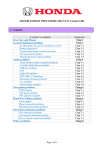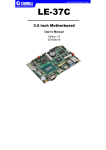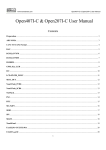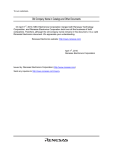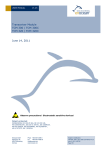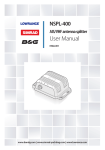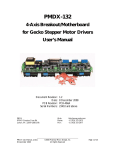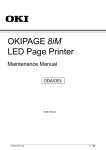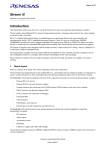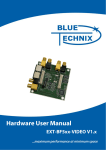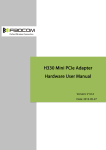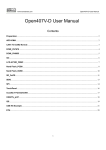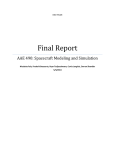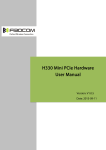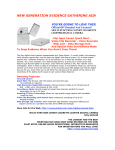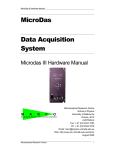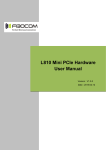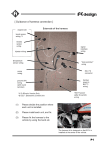Download SIM5210 Debug Board User Manual
Transcript
SIM5210 Debug Board User Manual Designed by SIMCOM Ltd,. 4th Jan 2007 SIM5210 Debug Board User Manual Confidential Designed by SIMCOM Document Name: SIM5210 Debug Board User Manual Version: Date: Doc Id: Status: 1.1 2007-06-29 SIM5210_debug_V1.1 General Notes Simcom offers this information as a service to its customers, to support application and engineering efforts that use the products designed by Simcom. The information provided is based upon requirements specifically provided to Simcom by the customers. Simcom has not undertaken any independent search for additional relevant information, including any information that may be in the customer’s possession. Furthermore, system validation of this product designed by Simcom within a larger electronic system remains the responsibility of the customer or the customer’s system integrator. All specifications supplied herein are subject to change. Copyright This document contains proprietary technical information which is the property of SIMCOM Limited., copying of this document and giving it to others and the using or communication of the contents thereof, are forbidden without express authority. Offenders are liable to the payment of damages. All rights reserved in the event of grant of a patent or the registration of a utility model or design. All specification supplied herein are subject to change without notice at any time. Copyright © SIMCOM Limited. 2006 SIM5210_Debug_V1.1 Page 2 of 15 SIM5210 Debug Board User Manual Confidential Designed by SIMCOM Contents Contents ............................................................................................................................................3 1 Introduction....................................................................................................................................5 1.1 Related documents ..............................................................................................................5 1.2 Terms and abbreviations......................................................................................................5 2 Product concept..............................................................................................................................6 2.1 The Debug Board key features at a glance..........................................................................6 3 Application interface......................................................................................................................6 3.1 Board view ..........................................................................................................................7 3.2 Interface description............................................................................................................9 SIM5210_Debug_V1.1 Page 3 of 15 SIM5210 Debug Board User Manual Confidential Designed by SIMCOM Version history Data Version Description of change Author 2007-01-04 01.00 Origin dingyiru 2007-06-29 1.1 Update the image of the board dingyiru SIM5210_Debug_V1.1 Page 4 of 15 SIM5210 Debug Board User Manual Confidential Designed by SIMCOM 1 Introduction This document describes the structure of SIM5210 Debug Board, It also describes how to use this board to support custom to use SIM5210 to design their applications 1.1 Related documents Table 1: Related documents SN Document name Remark SIM5210_HD_V1.1 SIM5210 HARDWARE SPECIFICATION 1.2 Terms and abbreviations Table 2: Terms and abbreviations Abbreviation Description SIM5210_Debug_V1.1 Page 5 of 15 SIM5210 Debug Board User Manual Confidential Designed by SIMCOM 2 Product concept The Debug board is designed for custom to design their applications by using the 3G module SIM5210 easily . All the functions of the SIM5210 can be used by this board. One can use UART, USB interface to communicate with the SIM5210, and can design their camera phone by SIM5210, There is one UART interface, one USB 2.0 interface, one Simcard interface , one T-FLASH card interface, two camera interfaces, and four audio interface on the board. One can connect the UART and the USB interface to a computer directly. 2.1 The Debug Board key features at a glance Table 3: Debug board key features Feature Implementation Power supply 1: Single supply voltage 6.0V – 9.0V at J13and J16 2: 3.5V~4.3V at J19 functions z z z z z z z z UART interface USB2.0 interface SIMCARD interface TFLASH interface. Two sensor interface Onkey Keypad Audio interface 3 Application interface All hardware interfaces that connects SIM5210 to the customers’ cellular application platform is through a 70-pin 0.5mm pitch board-to-board connector. Sub-interfaces included in this board-to-board connector are described in detail in following chapters: Electrical and mechanical characteristics of the board-to-board connector are specified in Chapter 6. There we also order information for mating connectors. SIM5210_Debug_V1.1 Page 6 of 15 SIM5210 Debug Board User Manual Confidential Designed by SIMCOM 3.1 Board view USB connector Audio JACK JTAG PHONE ON Level shift Audio out DB9 RS232 70 PIN B to B UART connect interface (cmos level) USIM+TFLASH HOLDER DC in DC-DC LM317 Reset switch KEYPAD SIM5210_Debug_V1.1 RGB sensor YUV sensor connector connector Page 7 of 15 SIM5210 Debug Board User Manual Confidential Designed by SIMCOM Table 4:On Board Connector description No Name 1 J1 70PIN B to B connector, connect to SIM5210 module 2 J2 RGB sensor connector, An OV2640 2.0M sensor can be used 3 J3 USIM and T-FLASH card holder. 4 J4 No use 5 J5 YUV sensor connector, An OV7670 0.3M sensor can be used 6 J6 USB connector 7 J7 DC-DC out test point, connect this pin to J19 when use a external DC power supply, you can use a 3.5V~4.3V DC supply to J19 when you not use a external DC supply 8 J8 JTAG connector, for download firmware only 9 J9 Audio interface connector, MIC, receiver, speaker and line in are in this connector, also the Phone on and a GPIO pin are in this connector. 10 J10 UART connector. the UART interface is in CMOS level. 11 J11 DB9 UART interface. This can be connect to a PC directly 12 J12 Receiver +, connect to a receiver with the J14 together 13 J13 External DC supply input, SIM5210_Debug_V1.1 Description Page 8 of 15 SIM5210 Debug Board User Manual Confidential Designed by SIMCOM 14 J14 Receiver -, connect to a receiver with the J12 together 15 J15 no use 16 J16 GND ( for external DC power supply) 17 J17 Connect to DB9 connector DSR of J11 18 J18 Audio jack, for headset use. 19 J19 VABT input, if you don’t use the DC-DC circuit, you can supply a 3.5V~4.3V DC supply to this pin directly 20 J20 MIC input PIN 3.2 Interface description 3.2.1 B to B connector J1 This 70 pin plug use to connect to SIM5210 module. The plug is AXK870145WG which a product of NAIS. 3.2.2 RGB sensor connector J2 This 24PIN B to B socket is used to connect a RGB sensor ,the socket is made by HRS, PIN24 PIN13 PIN12 PIN1 SIM5210_Debug_V1.1 Page 9 of 15 SIM5210 Debug Board User Manual Confidential Designed by SIMCOM PIN LIST PIN No Define PIN No Define 1 NC 24 Y0 2 AGND 23 Y1 3 SIO_D 22 Y4 4 AVDD 21 Y3 5 SIO_C 20 Y5 6 RST 19 Y2 7 VSYNC 18 Y6 8 PWDN 17 PCLK 9 HREF 16 Y7 10 DVDD 15 AGND 11 IOVDD 14 Y8 12 Y9 13 XCLK 3.2.3 SIMCARD and T-FLASH card holder J3 J3 is a two connector in one package. the upstairs is SIMCARD holder. downstairs is T-FLASH card holder PIN16 PIN7 PIN14 Pin 1 Pin6 Note:the Pin No isn’t in sequence, detail description is in follow table. SIM5210_Debug_V1.1 Page 10 of 15 SIM5210 Debug Board User Manual Confidential PIN No Define Designed by SIMCOM PIN No Define 1 SIMVCC 16 SW2 4 GND 15 SW1 2 SIMRST 7 TF-DATA2 5 SIMVPP 8 TF-DATA3 3 SIMCLK 9 TF-CMD 6 SIMIO 10 TF-VDD 11 TF-CLK 12 GND 13 TF-DATA0 14 TF-DATA1 3.2.4 J4 just for test use 3.2.5 YUV sensor connector J5 J5 is a 34pin B to B connector which produced by NAIS, the PART NO is AXK834145WG PIN18 PIN34 PIN17 SIM5210_Debug_V1.1 PIN1 Page 11 of 15 SIM5210 Debug Board User Manual Confidential PIN No Define Designed by SIMCOM PIN No Define 1 DGND 34 NC 2 PCLK 33 NC 3 NC 32 NC 4 NC 31 NC 5 RST 30 Y7 6 NC 29 Y6 7 NC 28 Y5 8 SIO_D 27 Y4 9 SIO_C 26 Y3 10 NC 25 Y2 11 NC 24 Y1 12 NC 23 Y0 13 PWDN 22 NC 14 NC 21 XCLK 15 IOVDD 20 AGND 16 AVDD 19 VSYNC 17 DVDD 18 HREF 3.2.6 USB connector J6 It is a normal 4Pin USB connector 3.2.7 SIM5210 DC supply input J7,J19 J7 is the DC-DC out , J19 is connected to J7 through a 0 resistor, if one want to use a battery to supply the circuit, the resistor can be removed and connector the battery +to J19. 3.2.8 JTAG connector J8 JTAG connector is used to debug the SIM5210, or used to download firmware to the SIM5210 when the firmware is damaged. Note that one can download firmware through the USB connector except the loader SIM5210_Debug_V1.1 Page 12 of 15 SIM5210 Debug Board User Manual Confidential Designed by SIMCOM software in the SIM5210 is damaged. 3.2.9 Audio interface connector J9 PIN20 PIN2 PIN19 PIN1 PIN NO DEFINE PIN NO DEFINE 1 SPK1 2 GPIO 3 GND 4 PHONE ON 5 SPK2 6 GND 7 GND 8 PCM_DOUT 9 LINE_IN_L 10 PCM_DIN 11 LINE_IN_R 12 PCM_CLK 13 GND 14 PCM_SYNC 15 MIC_P 16 GND 17 MIC_M 18 EAR_M 19 GND 20 EAR_P 3.2.10 UART interface J10 The odd pins of this connector is connected to the SIM5210 UART interface. The level is CMOS level(VH=2.6V, VL<0.3V) .The even PINs is connected to J11 which is the RS232 level UART. When you want to use J11 connect to a PC, you must not connect the odd PINs to even PINs. SIM5210_Debug_V1.1 Page 13 of 15 SIM5210 Debug Board User Manual Confidential Designed by SIMCOM PIN1 PIN19 PIN2 PIN NO PIN20 DEFINE PIN NO DEFINE 1 UART_TXD 2 TXD 3 UART_CTS 4 CTS 5 UART_DCD 6 DCD 7 UART_RI 8 RI 9 UART_DTR 10 DTR 11 UART_RTS 12 RTS 13 UART_RXD 14 RXD 15 GND 16 GND 17 NC 18 NC 19 NC 20 NC 3.2.11 UART (RS232 level) interface J11 J11 is 9 PINs standard RS232 UART interface. It can be connected to a PC directly SIM5210_Debug_V1.1 Page 14 of 15 SIM5210 Debug Board User Manual Confidential Designed by SIMCOM PIN No Define 1 UART_DCD (connect to PC DCD) 2 UART_RXD (connect to PC TXD) 3 UART_TXD (connect to PC RXD) 4 UART_DTR (connect to PC DSR) 5 GND 6 CONNECT TO J17 7 UART_RTS (connect to PC CTS) 8 UART_CTS (connect to PC RTS) 9 UART_RI (DSR) (connect to PC RI) 3.2.12 MIC/receiver interface J12,J14,J20 J12,J14 and J20 are solder mask ,One can connect the MIC AND a receiver to those point ,note that the MIC’s polarity must be correct. 3.2.13 External DC supply connector J13,J16 One can connect these PIN to a DC regulator, the output voltage of the regulator shall be large than 6Vand less than 35V 3.2.14 Headset connector J15,J18 J18 is a audio jack which has 6 pins .it has connected to a MIC and two speakers, the speaker resistor should be a 32 OM SIM5210_Debug_V1.1 Page 15 of 15















